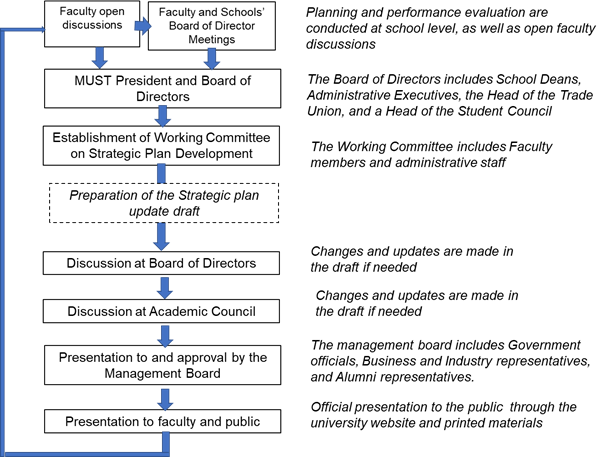The primary level units that implement the program, such as SBAH, departments, program teams, and lecturers, develop work plans at their level, determine the level of expectation, and evaluate their performance at the end of the year. Also, evaluation of the student’s achievement is done regularly, and continuous improvement is being made. Evaluation of the student’s achievement, performance expectations, and outcomes can be seen in Standard 7.
Table 1. Performance Expectations for Student Achievement
|
|
Performance |
|||||||
|
Attrition |
Less than 10% |
|||||||
|
Job placement rates) |
|
|||||||
|
Retention |
Greater than 40% |
|||||||
|
Undergraduate programs students’ performance: |
2020 |
2021 |
2022 |
2023 |
||||
|
Goal |
Result |
Goal |
Result |
Goal |
Result |
Goal |
Result |
|
|
Financial management |
87 |
87 |
120 |
113 |
148 |
140 |
157 |
143 |
|
Human resource management |
68 |
68 |
104 |
98 |
134 |
130 |
124 |
115 |
|
International Business management |
58 |
58 |
106 |
91 |
108 |
68 |
62 |
52 |
|
Information system management |
74 |
74 |
91 |
92 |
102 |
62 |
50 |
40 |
|
Marketing management |
86 |
85 |
127 |
127 |
145 |
137 |
141 |
118 |
|
Business administration 2+2 joint program (Seoul Tech) |
- |
- |
65 |
25 |
60 |
54 |
69 |
56 |
|
Business administration |
243 |
243 |
147 |
142 |
48 |
47 |
72 |
67 |
|
Graduate programs students’ performance: |
2020 |
2021 |
2022 |
2023 |
||||
|
Financial management |
|
|
18 |
23 |
14 |
16 |
17 |
10 |
|
Human resource management |
|
|
79 |
57 |
40 |
62 |
70 |
43 |
|
International business management |
|
|
3 |
1 |
|
1 |
|
|
|
Information system management |
|
|
3 |
2 |
|
2 |
|
1 |
|
Marketing management |
|
|
9 |
13 |
1 |
5 |
6 |
3 |
|
Production management |
|
|
30 |
12 |
23 |
16 |
24 |
26 |
|
Business administration |
|
|
31 |
23 |
34 |
16 |
32 |
32 |
See the Standard 7 in detail
In 2020, MUST has developed a strategic plan for the development of MUST until 2030. According to the plan, MUST has set a goal to be one of the top 1000 schools in the world in 2030; to develop into a world-class university; and to participate in the future development of the government and business organizations responsible for solving problems. The SBAH’s planning is focused on implementing the goals and objectives within the framework of the 5 priority strategic directions in the plan.
Table 1. 1. MUST’s Leadership processes – Approach
|
Process Description |
Person Responsible |
Implementation Schedule |
|
MUST Mission and Vision Review |
MUST Rector and Board of Directors |
|
|
Faculty and lecturers |
|
|
|
School plan |
School Dean |
|
|
Department Plan |
Head of department and teachers |
|
|
Enrollment Number Monitoring |
Academic affairs and digital transformation office of MUST |
|
|
Vice-dean for academic affairs |
|
|
|
Head of department and teachers |
|
In order to determine the vision, mission and strategy of MUST until 2030, a three-phase discussion and research was organized to gather feedback and information from the interested parties of the university. The parties will share their opinions and participate actively in the development and successful implementation of the MUST-2030 strategy (Figure 1.1).

Figure 1.1.A.1 The process of developing MUST’s strategic plan, including its vision, mission and values



